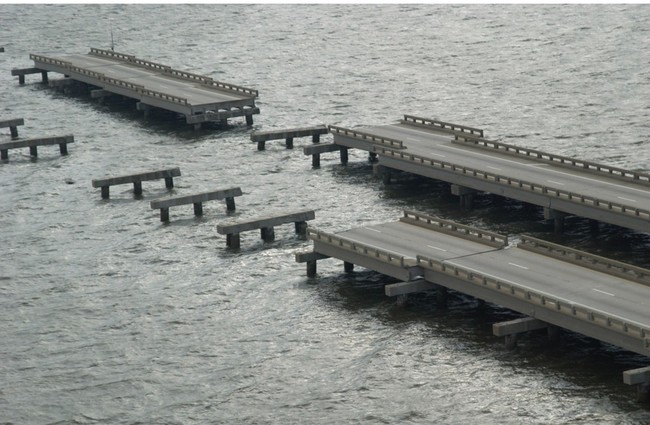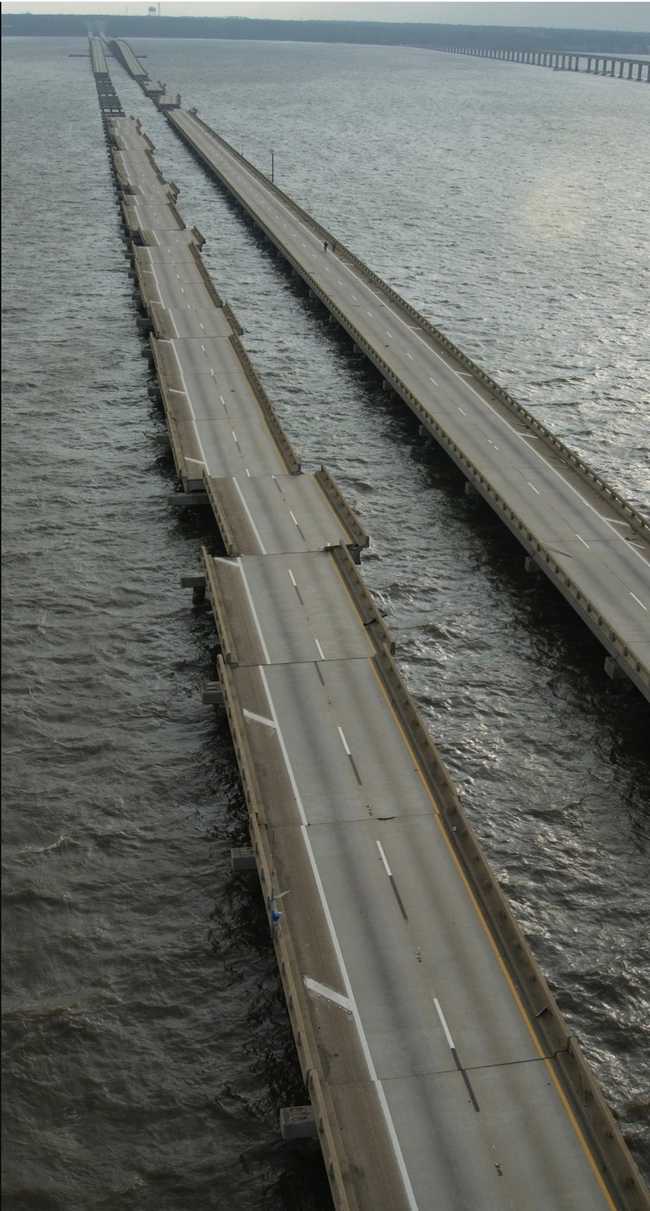I figured, since we were going into Easter weekend with everything going on in Baltimore and points beyond, I’d chill out a bit. Be done with depressing news and political rants.
I thought maybe I’d tell you guys a story about a real place where something once really happened, and it was really pretty cool when it was all said and done.
‘Cuz America.
Gather round children, and you shall hear,
Of the storm that roared in and ruined our year.
It was late summer in 2004. We were all sitting in Pensacola, holding our breaths as the rest of the state was repeatedly sideswiped or smacked by one hurricane after another. The fact that none of them seemed to wind up where they were predicted only added to everyone’s anxiety level. The worst offender so far had been Hurricane Charley’s hard right turn into Punta Gorda, well south of the angled track they’d predicted into Tampa, and north.
And the season was young yet – nowhere close to hitting its stride.
YOICKS
But life goes on, and this miserable humid heat builds and you deal with it. I had other things on my mind in any event, as my elderly Daddy and his wife had moved into the neighborhood, and, more importantly, hubs had had major shoulder reconstructive surgery on the first of September. The kind of “major” where they go in planning on two hours but emerge 5 hours later going, “Holy crap – that shoulder was a mess. You’re not gonna believe what we had to do…”
Because it was a Labor Day weekend to boot, everyone booked out of the Naval Hospital as fast as they could. This was problematic. I am no Florence Nightingale, but still had to take a guy who’d been cut to pieces HOME that evening.
Yeah. I’ve never forgiven the Navy for any of it.
A week later, at his first post-op with his surgeon – and once I unloaded on him AND Patient Affairs – I asked, “What do I do with him if there’s a storm? Can I bring him here for safe-keeping? I can’t have the roof drop on him if we’re sheltering in a hall. He’ll bleed to death.” The surgeon looked at me as if I were barking mad.
I wasn’t nuts. They were already watching what had been Tropical Depression Nine on 2 Sep, Tropical Storm Ivan the next day, and Hurricane Ivan by the 5th.
Anything with that whack name couldn’t be good, and I had a bad feeling about it. It only got worse as Ivan seemed fond of hanging around Cat 5 strength and determined to head our way.
Forecasters told us he was headed to Biloxi. I spent a good portion of the evening of the 15th doing the math on the hurricane-force wind extension and the 130 miles to Biloxi. I thought we’d probably be rockin’ and rollin’, but we could handle it. I was pretty comfortable until my little brother called a tad after 9 p.m. and upset the apple cart
I wrote about it on Ivan’s 10 year anniversary. He asked what we were going “to do.” I was confused.
…“Oh, we’re okay. It’s going to Biloxi.”
“No, it’s not. It’s headed right towards you.”
Damn right turn again.
We got smacked good and hard. 145 mph gusts, close to a Cat 4 at landfall – they’re not sure as many of the wind gauges were gone with the wind. And our wee, humble cottage was only 17 miles from where the eye came ashore in that dreaded northeast quadrant.
People in the rest of the country had no idea what happened here in our little, rural Redneck Riviera. They still don’t. 90% of the structures in the county were damaged or destroyed.
Weeks later, flying into our reopened airport, a friend was sitting next to a lady looking out the airplane window and heard her say, “Oh, that’s why I LOVE Florida!” He asked her why. She replied it was because everyone had swimming pools, of course.
He said, “May I?” and looked past her through the window to see what she was talking about.
“Lady, those are FEMA tarps.”
But this is a bridge story—the Escambia Bay Bridge. It’s the I-10 bridge connecting Escambia and Santa Rosa counties and a vital artery not only for interstate traffic but also for local commerce. We are surrounded by water, and if that bridge is out, as we like to say, “you can’t get there from here.”
This is what was left after Ivan created a 13-foot storm surge which drove 35-foot waves – for hours – all the way through Pensacola Bay into Escambia Bay. The surging waters were high enough to jostle or completely float the bridge’s 250-ton concrete roadway sections normally nestled on pylons above the water.
The stark, eviscerated remains of the tractor-trailer dangling on the precipice of a missing bridge section were a horrific testimony to the power of nature. If only Roberto Alverado had listened to his mom.
…Against the warnings of his mother, he had agreed to haul a load of fruits and vegetables from Brownsville, Texas to Miami.
He got caught in the storm, but attempted to cross the bridge regardless. He drowned when the cab of his 18-wheeler detached and fell into Escambia Bay…

When we first heard about the damage and then finally saw pictures, it took our breath away. It looked to be so impossible as to be unthinkable. What did they mean, the bridge was GONE?

But gone it was – both of the twin structures.
…During the hurricane, the impact of the storm surge pushed 58 spans off bridge supports and shifted another 66 spans…
…In the westbound bridge, a total of 12 spans and seven piers were destroyed, and 19 spans were misaligned. In the eastbound bridge, a total of 51 spans and 25 piers were destroyed, and 33 spans were misaligned…
3400 linear feet of bridge went into the water.
Holy smokes – we were in a pickle. Not only was the major southern east-west interstate artery completely jacked up – the detour around was an hours-long nightmare for semis – but isolated as we normally are, gasoline, fuel, fresh food like salads, chicken, etc. weren’t being delivered because there were questions about available fuel supplies to get trucks back out once they got here. Logistics became a challenge immediately.
But there was nothing as daunting as those tons and tons of concrete laying in the roiled waters of Escambia Bay and the big, empty pylons rising above them. What to do?
The answer was American ingenuity and to get moving.
Boy, did they ever.
The first order of business was to cobble together emergency repairs to make at least one span passable. What happened next was absolutely magnificent and a testament to American “git ‘er done” with a little bonus for incentive. Plus, they recycled.
…In Phase 1, the contractor drove 28 new piles prior to lifting existing spans off the eastbound bridge and placing them on missing sections of the westbound bridge. Misaligned westbound spans were adjusted and the westbound bridge was re-opened to one lane of traffic in each direction…
The contract gave them 24 days. They did it in 17. Earned a tidy bonus and worth every penny.
Phase 2?
…In Phase 2, the contractor repaired the eastbound bridge with existing spans and 58 temporary Acrow (metal) panel deck spans. It was re-opened to one lane of traffic in November 2004. Permitted and over-sized vehicles were not allowed to travel on the temporarily repaired bridges…
They were a little ahead on this, too.
…Phase 2 of the contract required the eastbound bridge to be repaired and re-opened within 90 days. The contractor opened the eastbound bridge to one lane of traffic in 63 days, 27 days ahead of schedule…
All this with no electricity or running water at the site, while the design-build team and FDOT staff worked from an office in Tallahassee.
Outstanding communication, coordination, and motivation will get things done.
Design work started within a year on replacement spans for the crippled older bridges, and, again, contractors and the state were up to the task of working with each other.
…Skanksa designed and constructed two replacement bridges to stand 25 feet above water, more than twice the height of the original bridges. The project was completed in two years and eight months. Although Skanska had to work through the challenges of rescheduling the project during multiple hurricanes in 2005 – including Katrina – the project was completed on time and on budget.
Boy, are they ever schweet to travel over, too.
So from this…
The satellite photo of Ivan is something as menacing as you will ever see.
And it sucked to be under it, believe me. https://t.co/pcfpzAu5qf pic.twitter.com/iXuUI5SdAL
— tree hugging s*ster 🎃 (@WelbornBeege) March 29, 2024
…to this…
…is the happy bridge story you’ve probably never heard before.
It can be done. Thanks for listening.
The End.
Read the full article here